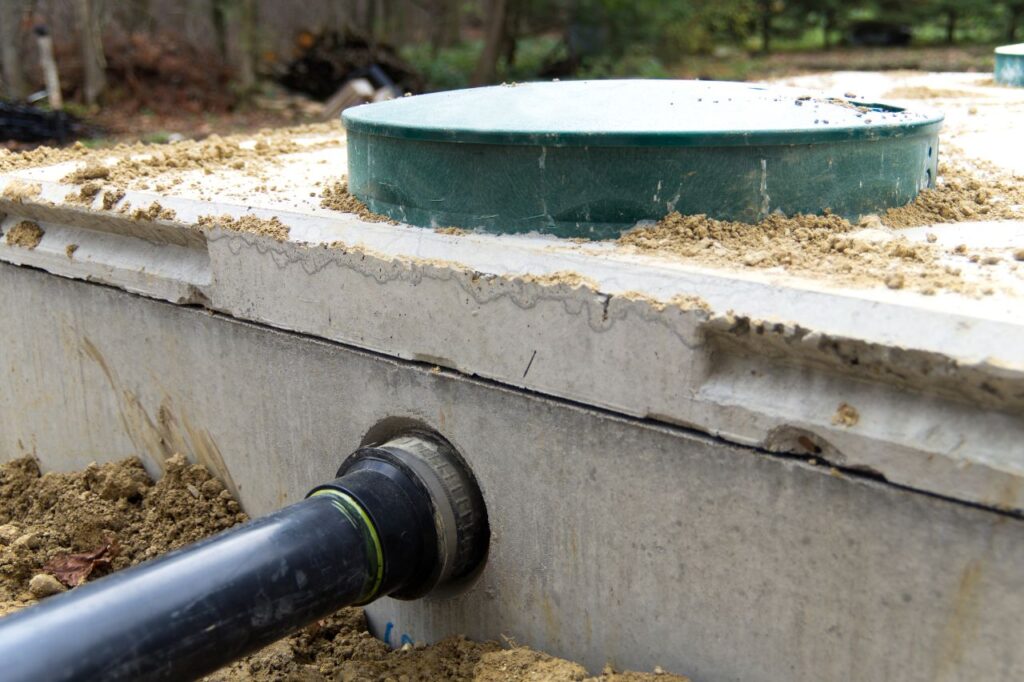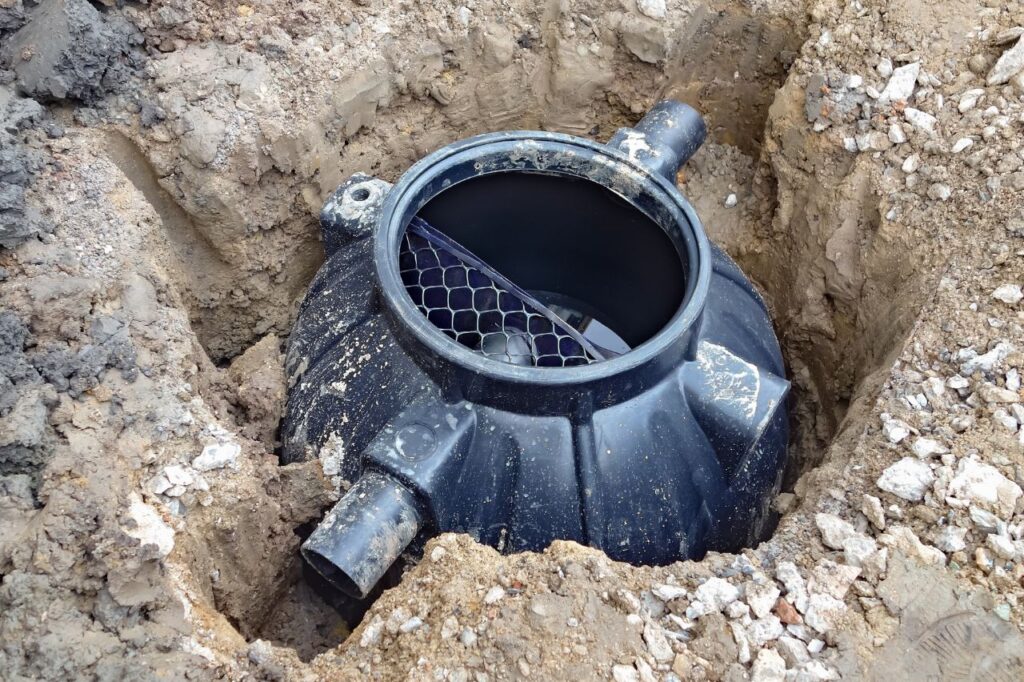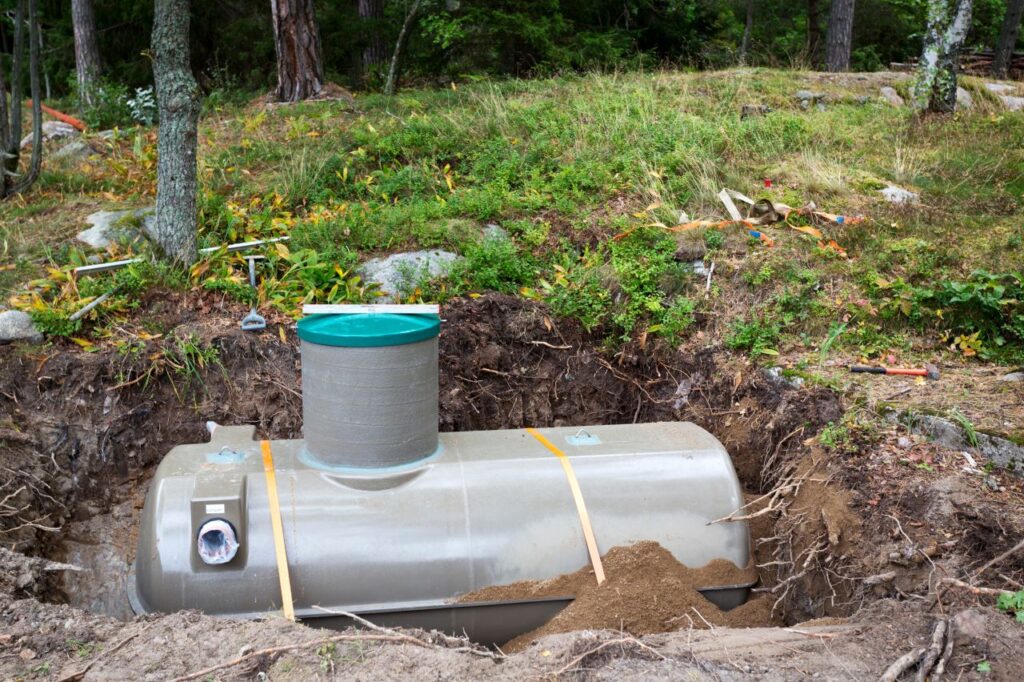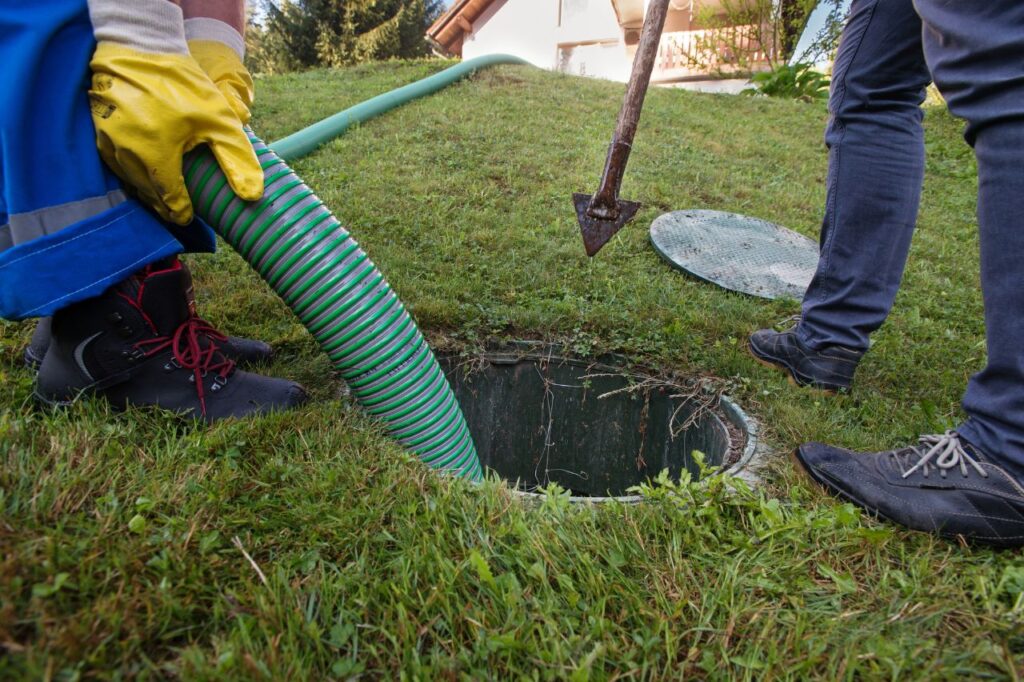Septic tanks are the unsung heroes of wastewater management, serving as underground treatment systems in areas without access to centralized sewer networks. This informative article delves into the inner workings of septic tanks, shedding light on their crucial role in waste separation and natural treatment processes.
What is covered:
- Septic tanks are underground wastewater treatment systems used in areas without centralized sewer systems.
- The natural processes inside the septic tank separate solid waste from liquid waste through anaerobic digestion.
- Proper maintenance, including regular inspections and pumping every 3 to 5 years, is essential for the longevity and efficiency of septic tanks.
- Septic tanks have environmental benefits when well-maintained, as they treat wastewater effectively and contribute to water conservation.
How septic tanks work

Septic tanks are underground wastewater treatment systems that are commonly used in areas where there is no access to centralized sewer systems. They are usually made of concrete, fiberglass, or plastic and are buried in the ground, close to the property they serve.
When wastewater from your home enters the septic tank, it undergoes a series of natural processes that separate the solid waste from the liquid waste. The heavy solids sink to the bottom of the tank and form a layer of sludge, while the lighter materials, such as oils and fats, rise to the top and create a layer of scum. The liquid waste, known as effluent, is then discharged into the drain field, where it is further treated by the soil.
Septic tanks rely on the natural process of anaerobic digestion to break down the solid waste. Bacteria and other microorganisms present in the tank help decompose the waste, converting it into gases and liquids. The gases are released into the atmosphere, while the liquids are absorbed by the soil.
Common misconceptions about septic tanks
Despite their importance, septic tanks are often misunderstood. Let’s debunk some common misconceptions about septic tanks:
Misconception #1: Septic tanks are a breeding ground for bacteria and diseases.
In reality, septic tanks are designed to contain and treat waste in a safe and controlled manner. The anaerobic digestion process that occurs inside the tank helps break down harmful bacteria and pathogens, reducing the risk of contamination. Additionally, the drain field and the surrounding soil act as natural filters, further purifying the effluent before it reaches groundwater sources.
Misconception #2: Septic tanks require frequent pumping and maintenance.
While regular maintenance is important for the longevity of your septic system, it does not necessarily mean frequent pumping. The frequency of pumping depends on various factors such as the size of the tank, the number of occupants in the house, and the volume of wastewater generated. On average, septic tanks need to be pumped every 3 to 5 years. However, it is crucial to have your tank inspected regularly to ensure it is functioning properly.
Misconception #3: Septic tanks are harmful to the environment.
On the contrary, septic tanks can actually benefit the environment when properly maintained. The anaerobic digestion process in septic tanks helps break down waste and reduces the amount of harmful substances that are released into the environment. Moreover, the effluent that is discharged into the drain field is further treated by the soil, which acts as a natural filter, removing contaminants and pathogens.
Surprising fact #1: Septic tanks can last for decades

Contrary to popular belief, septic tanks are built to last. With proper installation and regular maintenance, a well-constructed septic tank can withstand the test of time and function efficiently for several decades. The lifespan of a septic tank largely depends on factors such as the material it is made of, the quality of installation, and the level of maintenance it receives.
Concrete septic tanks, for example, are known for their durability and can last up to 40 years or more. Fiberglass and plastic tanks also have a long lifespan, typically lasting between 20 to 30 years. Regular inspections and pumping, as well as avoiding excessive water usage and the disposal of harmful substances, can significantly extend the life of your septic tank.
Surprising fact #2: Septic tanks can benefit the environment
Septic tanks are not only a practical solution for managing wastewater in areas without access to centralized sewer systems, but they also have environmental benefits. When properly designed, installed, and maintained, septic tanks can treat wastewater effectively, reducing the risk of contamination and pollution.
The anaerobic digestion process that occurs inside the septic tank helps break down organic matter and convert it into harmless byproducts. The effluent that is discharged into the drain field is further treated by the soil, which acts as a natural filter, removing contaminants and pathogens. This natural treatment process helps protect groundwater sources and nearby bodies of water from pollution.
In addition, septic tanks can also contribute to water conservation. By relying on natural processes and the absorption of effluent into the soil, septic systems reduce the need for excessive water usage and can be more sustainable than traditional sewer systems.
Surprising fact #3: Regular maintenance is crucial for septic tank longevity
To ensure the longevity and optimal performance of your septic tank, regular maintenance is key. Neglecting proper maintenance can lead to costly repairs and potential environmental hazards. Here are some essential maintenance tasks that should be performed:
1. Regular inspections: Have your septic tank inspected by a professional at least every 3 to 5 years, or as recommended by your local health department. Inspections can help identify any issues or signs of potential problems before they escalate.
2. Pumping: While the frequency of pumping depends on various factors, it is generally recommended to have your septic tank pumped every 3 to 5 years. Pumping removes the accumulated sludge and scum, preventing them from overflowing into the drain field and causing blockages or system failures.
3. Water conservation: Conserving water can help reduce the strain on your septic system. Avoid excessive water usage, fix any leaks promptly, and consider installing water-saving fixtures such as low-flow toilets and showerheads.
4. Proper waste disposal: Avoid flushing or disposing of harmful substances such as grease, oil, chemicals, medications, and non-biodegradable items down the drain or toilet. These substances can disrupt the natural processes inside the tank and cause damage to the system.
By following these maintenance practices, you can ensure the longevity and efficiency of your septic tank, saving you from costly repairs and potential health and environmental hazards.
Surprising fact #4: Septic tanks can handle more than just wastewater
While septic tanks are primarily designed to treat and manage wastewater, they are capable of handling more than just that. In addition to regular household wastewater, septic tanks can also process other types of organic waste, including food waste and organic yard waste.
By properly disposing of food waste through a garbage disposal unit or composting, you can reduce the strain on your septic system. However, it is important to note that excessive food waste can lead to an increase in solid waste accumulation, requiring more frequent pumping.
Similarly, organic yard waste such as grass clippings and leaves can be safely disposed of in the septic tank. These organic materials will decompose naturally and contribute to the overall functioning of the system. However, avoid disposing of large volumes of yard waste at once, as it can overwhelm the tank and hinder its performance.
Surprising fact #5: Septic tanks can be installed in various soil types

One of the common misconceptions about septic tanks is that they can only be installed in specific soil types. In reality, septic tanks can be installed in a wide range of soil conditions, as long as certain considerations are taken into account.
Different soil types have varying rates of permeability, or the ability to allow water to pass through. Soil with high permeability, such as sandy soil, allows water to drain quickly, which can pose a challenge for the treatment of wastewater. On the other hand, soil with low permeability, such as clay soil, drains water slowly, potentially causing water to pool on the surface.
To overcome these challenges, septic systems can be designed with additional components such as gravel-filled trenches or sand filters to improve the treatment efficiency. By adapting the system to suit the soil conditions, septic tanks can be successfully installed in various soil types, ensuring effective wastewater treatment.
Surprising fact #6: Septic tanks require specific additives for optimal performance
To maintain the optimal performance of your septic tank, it is important to use specific additives that enhance the natural processes occurring inside the tank. These additives, often referred to as septic tank treatments, help break down organic matter, reduce odors, and prevent the accumulation of solids.
There are various types of septic tank additives available on the market, including bacteria-based additives and enzyme-based additives. Bacteria-based additives introduce beneficial bacteria into the septic tank, which help break down organic waste more efficiently. Enzyme-based additives, on the other hand, contain enzymes that accelerate the decomposition process.
It is important to note that not all septic tank additives are created equal. When choosing an additive, opt for products that are specifically formulated for septic tanks and have been tested and approved by regulatory agencies. Additionally, follow the manufacturer’s instructions for proper dosage and application.
While septic tank additives can enhance the performance of your system, they should not replace regular maintenance and pumping. Additives should be used as a supplement to proper maintenance practices, such as regular inspections and pumping.
Surprising fact #7: Septic tanks can be retrofitted for advanced technologies
As technology advances, so do the options for septic tank systems. If you have an older septic tank or are looking to upgrade your existing system, you may be surprised to learn that septic tanks can be retrofitted with advanced technologies to improve their efficiency and performance.
One such technology is the addition of an aerator or an air pump to the septic tank. These devices introduce oxygen into the tank, promoting aerobic digestion and speeding up the decomposition process. Aerobic digestion is more efficient than anaerobic digestion, resulting in better treatment of wastewater and reduced odors.
Another advanced technology that can be retrofitted to septic tanks is the addition of a media filter. Media filters are designed to further treat the effluent before it is discharged into the drain field. The filter media, typically made of sand or other porous materials, helps remove additional contaminants and pathogens, ensuring cleaner effluent.
If you’re considering retrofitting your septic tank with advanced technologies, it is important to consult with a professional to determine the feasibility and compatibility of the upgrades with your existing system. Additionally, check with your local health department or regulatory agency to ensure compliance with any regulations or permits that may be required.
Surprising fact #8: Proper landscaping can enhance septic tank efficiency

Landscaping plays a crucial role in the efficiency and performance of your septic tank system. By implementing proper landscaping practices, you can help maximize the treatment of wastewater, reduce the risk of system failures, and enhance the overall lifespan of your septic tank.
Here are some landscaping tips to consider:
1. Maintain a proper distance: Ensure that trees, shrubs, and other vegetation are planted at a safe distance from the septic tank and drain field. The roots of trees and plants can infiltrate the tank and drain field, causing blockages and potential damage to the system.
2. Avoid compacting the soil: Compacted soil can hinder the absorption of effluent into the drain field. Avoid parking vehicles or placing heavy objects on the drain field, as this can compact the soil and reduce its permeability.
3. Direct surface water away from the drain field: Proper drainage is essential to prevent excess water from pooling around the drain field. Ensure that rainwater and other surface runoff are directed away from the septic system to avoid overloading it.
4. Plant grass or shallow-rooted vegetation: Grass is an ideal ground cover for the drain field, as its shallow roots do not interfere with the septic system. Avoid planting deep-rooted vegetation or using the drain field for other purposes, such as parking or gardening.
By implementing these landscaping practices, you can help maintain the efficiency and longevity of your septic tank system, minimizing the risk of costly repairs and potential environmental hazards.
Surprising fact #9: Septic tanks can be emptied and cleaned by professionals
Regular pumping is an essential part of septic tank maintenance. Over time, solid waste accumulates in the tank, forming a layer of sludge at the bottom. If left unchecked, this sludge can build up and overflow into the drain field, causing blockages and system failures.
Septic tank pumping involves removing the accumulated sludge and scum from the tank, ensuring that it continues to function efficiently. While some homeowners may attempt to pump their septic tanks themselves, it is highly recommended to hire a professional for this task.
Professional septic tank pumpers have the necessary equipment and expertise to safely and effectively pump the tank. They can also inspect the tank for any signs of damage or potential issues, providing valuable insights and recommendations for proper maintenance.
The frequency of septic tank pumping depends on various factors such as the size of the tank, the number of occupants in the house, and the volume of wastewater generated. On average, septic tanks need to be pumped every 3 to 5 years. However, it is important to have your tank inspected regularly by a professional to determine the appropriate pumping schedule for your specific system.
Surprising fact #10: Septic tanks should be inspected regularly for potential issues

Regular inspections are crucial for the proper functioning and longevity of your septic tank system. Inspections can help identify any issues or signs of potential problems before they escalate, allowing for timely repairs and maintenance.
A professional septic tank inspector will assess various components of the system, including the tank, drain field, and associated pipes and fittings. They will check for signs of leakage, blockages, structural integrity, and overall system performance.
In addition to professional inspections, there are also visual inspections that homeowners can perform themselves. These inspections involve checking for signs of potential issues, such as foul odors, slow drains, wet spots or pooling water near the drain field, or gurgling sounds in the plumbing system.
Regular inspections, both professional and visual, are essential for the early detection of problems, ensuring that they are addressed before they worsen and lead to costly repairs. Consult with a professional to determine the appropriate inspection frequency for your specific septic tank system.
Final Thoughts
In closing, understanding how septic tanks work and their importance in wastewater treatment is crucial for homeowners and communities relying on these systems. By debunking common misconceptions, such as their environmental impact and maintenance requirements, we can appreciate the valuable role septic tanks play in protecting groundwater sources and nearby bodies of water from pollution. Emphasizing the surprising longevity and adaptability of septic tanks, we learn that proper maintenance and responsible waste disposal are key to their optimal performance. With advancements in technology and the potential for retrofitting, septic tanks continue to evolve as sustainable and effective solutions. By embracing the knowledge and best practices surrounding septic tanks, we can ensure their efficiency, protect the environment, and enjoy trouble-free wastewater management for years to come.

